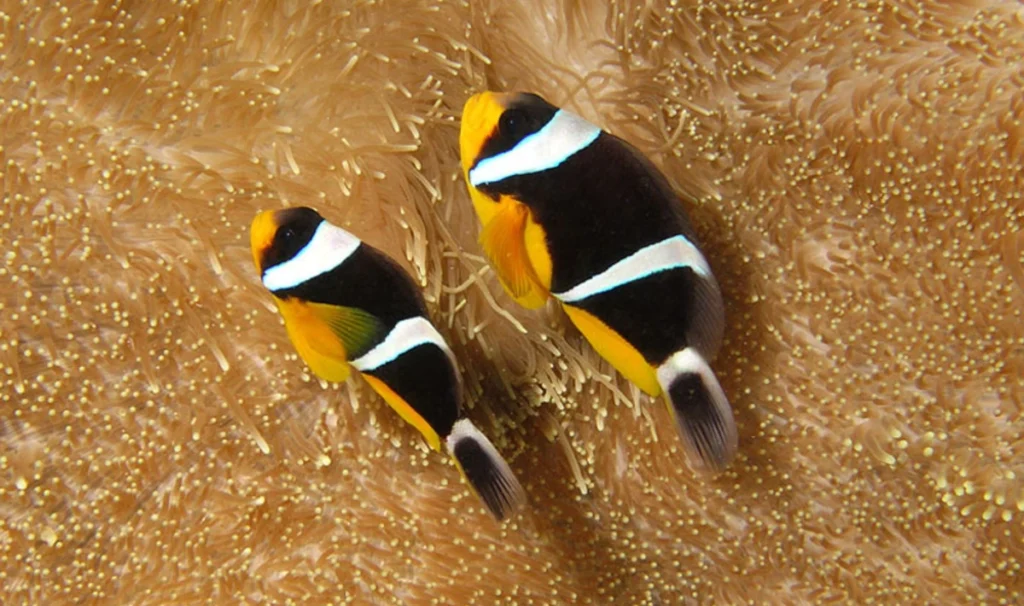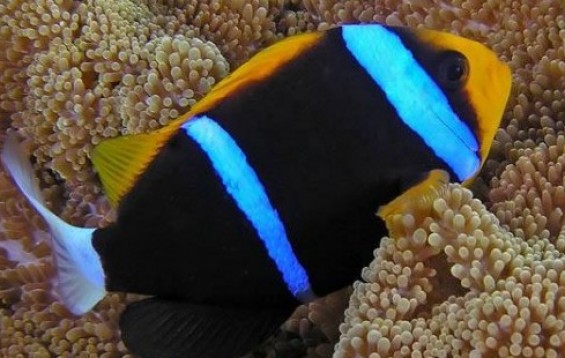Dark-tailed clown (Amphiprion melanopus), also known as red and black clown or the black-tailed clown, is a bright representative of clownfish with an unusual color. fiery red body and dark tail they create a unique contrast that distinguishes it from other types.
This species is widely distributed in the Pacific region and is quite popular among aquarists. Thanks to its endurance, interesting behavior and spectacular appearancethe dark-tailed clown is an excellent choice for marine aquariums.
In this article, we will take a closer look at:
✅ Scientific classification
✅ Appearance and coloring
✅ Habitat range
✅ Lifestyle and behavior
✅ Food
✅ Reproduction and sexual dimorphism
✅ Keeping in the aquarium
✅ Type and threat status

Scientific classification
✔ The Kingdom: Animals (Animalia)
✔ Type: Chordal (Chordata)
✔ Class: Lucheperi pisces (Actinopterygii)
✔ Row: Perch-like (Perciformes)
✔ Family: Pomacentrovye (Pomacentridae)
✔ Gender: Amphiprions (Amphiprion)
✔ View: Amphiprion melanopus
🔎 The name "melanopus" is derived from the Greek words "melano" (black) and " pus " (leg), which indicates its darkened color in the back of the body.
Appearance and coloring
The dark-tailed clown has spectacular contrast of red and black colorswhich makes it one of the most prominent representatives of clownfish.
🎨 Main features of coloring:
✔ The front part of the body is bright red or orange-red
✔ The back and tail are dark brown or black
✔ A single white or bluish stripe behind the eye
✔ The belly may be darker than the front of the body
✔ Maximum length-12-15 cm
🔥 This view is particularly impressive on a coral reef, where its bright colors contrast with the surrounding environment.
Habitat and habitat
🌍 Geographical distribution
Amphiprion melanopus it lives in:
✔ Western and Central Pacific
✔ Waters off Fiji, Tonga, Samoa, the Solomon Islands, the Great Barrier Reef and the Philippines
🏝 Typical biotopes:
✔ Coral reefs in the depths from 1 to 20 meters
✔ Lagoons with rich vegetation
✔ Lives in symbiosis with sea anemones
🌊 Symbiotic anemones:
The dark-tailed clown most often co-exists with the following anemone species::
✔ Entacmaea quadricolor (bubble anemone)
✔ Heteractis crispa (anemone carpet)
✔ Heteractis magnifica (majestic anemone)
🐠 Why do they live together?
✔ Anemone protects the clown from predators, and the clown protects the anemone from fish that can eat it
✔ Clown skin mucus prevents its burns from stinging anemone cells
Lifestyle and behavior
🔹 Territorial character
✔ Dark-tailed clown actively protects its territoryespecially around the anemone
✔ Often lives in nature in pairs or small groups
🔹 Social structure
✔ Dominant individual – the largest female
✔ Other individuals-males that they can change their gender if the female dies
🔹 Aggression
✔ Relatively aggressive towards other clownfish
✔ May conflict with other territorial fish
Food
🍽 Natural diet:
✔ Zooplankton
✔ Small crustaceans (corerods, mysids)
✔ Seaweed
🍽 Nutrition in aquariums:
✔ Frozen and live food (Artemia, krill)
✔ Specialized food for marine fish
✔ Additional Herbal Supplements
Reproduction and sexual dimorphism
🔹 Proteroginal hermaphroditism
✔ The largest male turns into a female after the female dies
🔹 Reproduction
✔ Female lays eggs from 200 to 500 eggs on a hard surface next to the anemone
✔ The male actively takes care of caviar, ventilating it with fins

Keeping in the aquarium
🟡 Aquarium requirements:
✔ Volume-from 100-150 liters
✔ Temperature-24-28°C
✔ Salinity-1.020-1.025
✔ Filtration-powerful, with a high-quality protein skimmer
🟡 Compatibility:
✔ Best to keep with anemone
✔ Peaceful reef fish – gubani, surgeons, blastopagusi
✔ You can't keep them together with other aggressive clowns
Threats and protected status
❗ Main threats:
✔ Destruction of coral reefs
✔ Overfishing for aquarium trade
✔ Climate change
🌱 Is it going to disappear?
Amphiprion melanopus it is not under threat of extinction, but needs to protect its natural environment.
Conclusion
The dark-tailed clown is bright and hardy fishwhich adapts easily to life in aquariums. unique coloring and interesting behavior they make it a favorite among both divers and marine aquarists.
💙 This fish not only adorns the reefs, but also demonstrates the magical world of symbiosis and social interaction in the underwater kingdom. 🌊🐠